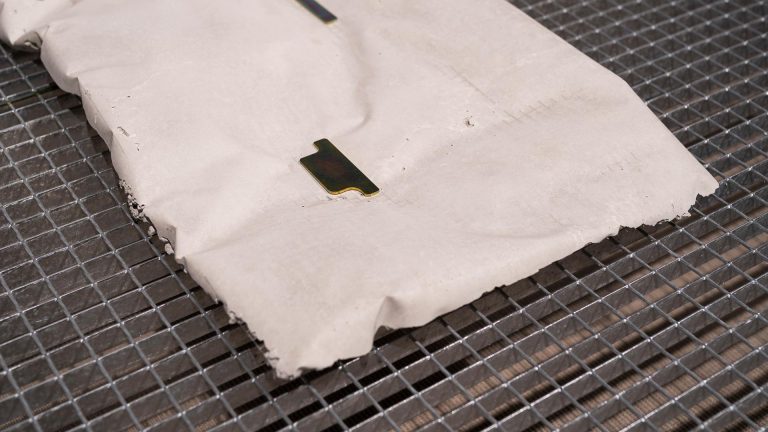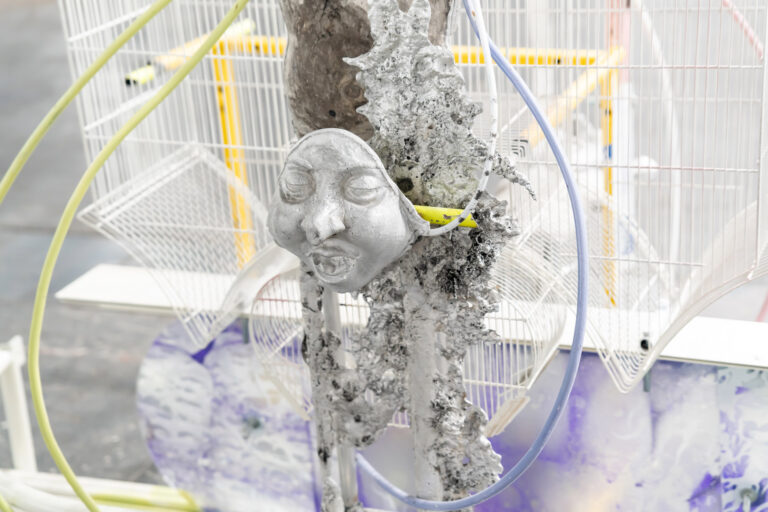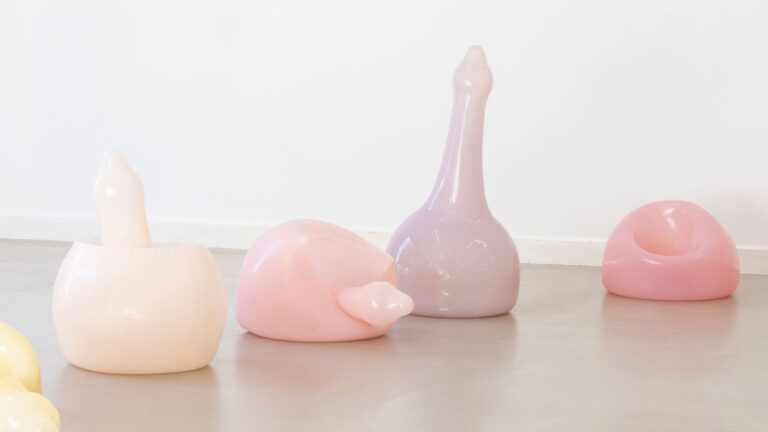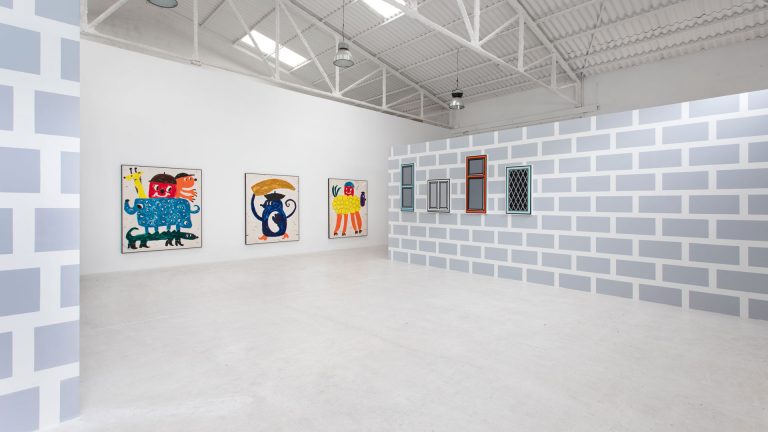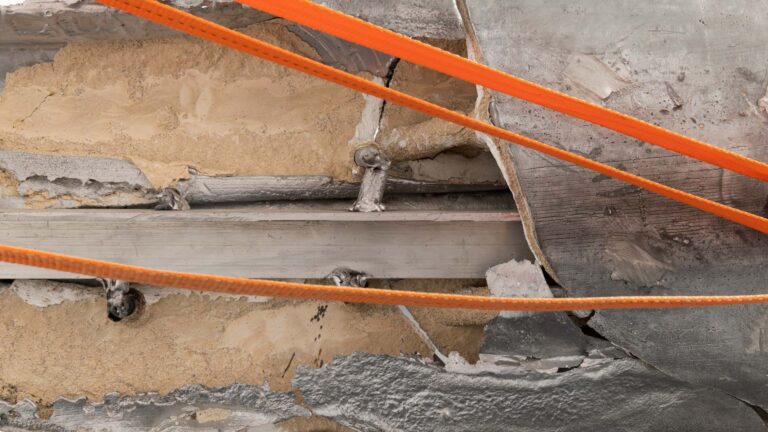Artists: Misha Bies Golas, Edu Carrillo, Etsu Egami, Tamara Feijoo, Priscila Fernandes , Patricia Gadea, Jorge Galindo, Gao Hang, Manuel M. Moreno, Gizela Mickiewicz, Carlos Pazos, Dasha Shishkin. Tomohiro Takahashi, Julia Wachtel
Exhibition title: Broken Piñata
Venue: L21 Gallery, Mallorca, Spain
Date: May 12 – July 1, 2022
Photography: Juan David Cortés / all images copyright and courtesy of the artists and L21 Gallery, Mallorca
I would like to take you to a delightful place where order and disorder are not excluding each other. A space where you will guess a method although, digging a little, you will discover pure chance. An absurd situation, scrupulously prepared. Trivial details, obsessively taken care of. Essential decisions, randomly made. Making it seem spontaneous what, in reality, is quite the opposite.
This place is a party.
Actually, it is a search.
Living is easy with eyes closed, misunderstanding all you see.
It looked like the result of an earthquake or an explosion. Something terrible had happened, but I didn’t know what it was. I remembered scenes from Fellini movies, an end-of-the party atmosphere, no music, few people. Torn papers, books on the floor, puny accumulations among empty shelves that were still there, for no apparent reason.
Libraries bring publications together. They need a classification system to make queries easier for users. If we talk about a bookshelf, something modest and private, personal or at most related to family, its order is perhaps less tedious and determined by more subjective matters: affection, neighborliness, the case, the color of the spine, the use, the size, etc.
It is unsettling to find a chaos of books. So many volumes that one can’t pass between the shelves without stepping on them. An unexpected collapse, dozens of scattered books covering the floor, open and overlapping; they are not stacked as if they had just been removed from their boxes, they have fallen abruptly and lie confusedly all mixed up. Something violent has happened. An explosion has left a shapeless mass, a sinister and ghastly mound of objects commonly associated with absolute order and serenity.
If we discovered a similar scene in our own house, we would immediately think of a robbery. But if it happened in a library, we would think of an act of vandalism. In both cases, violence generates disorder, the functionality of the volumes guarded there, classified and available on their respective shelves, has been broken. I saw this scene in a library in the summer of 2012, it was an installation by Matias Faldbakken. He was exploring disorder, another way of organizing a book collection, in a public space. It was an organized chaos, a methodical, sculptural, obsessive and detailed representation of some kind of violence towards the use assigned to books; the artist proposed a reflection on vandalism. Years later, reading a novel by the same author, I found the following: “For decades, people have been putting stickers along the frieze that runs along the bottom of portraits, prints and paintings in The Hills. We allowed this to happen. That’s how it’s always been. Although it happens less frequently now, a sticker still appears from time to time. It is not clear when this practice started, but there is some rumor about some “avant-garde” who frequented the place in the 1920s”.[1]
An uncontrollable accumulation of stickers, without an approach. A casual order and in transit, just like after moving house, while you unpack your books, as Benjamin points out: “I must ask you to join my disorder of crates that have been wrenched open, the air saturated with the dust of wood, the floor covered with torn paper, to join me among piles of volumes that are seeing daylight again after two years of darkness […] Every passion borders on the chaotic”.
Looking for the origin or simply a precedent of this improvised confusion we finally reach the myth, where Pandora’s box lies. This was a wedding present for Epimetheus and Pandora. Although it became popular as the generic “box”, it was actually a container quite similar to a piñata, specifically a kind of oval clay jar. The warnings to the bride and groom were clear: they were instructed not to open it. But curiosity was stronger than prudence and while seeking to discover its mysterious content and opening the box, what was kept inside was freed. It was not necessary to break it to cause a stir. Just lifting the lid was enough to release, suddenly and unexpectedly, all the evils of the world. The form was chaos. At the bottom of the empty box only hope remained.
“The shelving system has grown on itself, it has cracked and folded on itself due to a combination of wear, tear and repair; use, improvement and wear. One can imagine the shelves as a version of the restaurant’s sticker walls. Attempt upon attempt. Use upon use”.[2]
The game consists of breaking the piñata using a stick or cudgel while blindfolded and following the instructions of others who try to help (or confuse) the player. The piñata can have different shapes and be made with various materials. It is usually a clay or cardboard pot, or a wire structure covered with papier-mâché. It is hung high, preferably from a tree, and people wait for it to break and for its content to be released. It usually contains candies, fruits, toys, confetti, etc. To free the desired content, you have to break it. The prize falls in a disorganized manner, the confusion is part of the celebration. The protagonist proceeds blindly, guided by others, raising a stick and trying to hit the piñata until it breaks. “All order, precisely in these domains, is nothing more than a state of instability over the abyss”.[3] What order is this? What uses, improvements, wear and tear have led us here? We are at the party, a first search has ended, the band continues playing, we understand what is happening.
The smile’s returning to the faces…
-Francesco Giaveri
Scraps
“But I will go even further: the chance, the fate, that with their colors impregnate the past that is under my eyes, are offered there at the same time to the senses, through the usual hodgepodge of books. For that kind of possession, what is it but a disorder in which the custom has become so familiar that it can acquire the appearance of order?”.[4]
[1] Matias Faldbakken, El camarero [The Hills], translation by Antón Lado, Duomo Ediciones, Barcelona, 2021, p. 25
[2] Matias Faldbakken, The Waiter [The Hills], traducción de Antón Lado, Duomo Ediciones, Barcelona, 2021, p. 96
[3] Walter Benjamin, Unpacking My Library, traducción de Fernando Ortega, José J. De Olañeta Editor, Barcelona, 2015, pp. 33
[4] Walter Benjamin, Unpacking My Library, traducción de Fernando Ortega, José J. De Olañeta Editor, Barcelona, 2015, pp. 31-33
Broken Piñata, 2022, exhibition view, L21 Gallery, Mallorca
Broken Piñata, 2022, exhibition view, L21 Gallery, Mallorca
Broken Piñata, 2022, exhibition view, L21 Gallery, Mallorca
Broken Piñata, 2022, exhibition view, L21 Gallery, Mallorca
Broken Piñata, 2022, exhibition view, L21 Gallery, Mallorca
Broken Piñata, 2022, exhibition view, L21 Gallery, Mallorca
Broken Piñata, 2022, exhibition view, L21 Gallery, Mallorca
Broken Piñata, 2022, exhibition view, L21 Gallery, Mallorca
Broken Piñata, 2022, exhibition view, L21 Gallery, Mallorca
Broken Piñata, 2022, exhibition view, L21 Gallery, Mallorca
Broken Piñata, 2022, exhibition view, L21 Gallery, Mallorca
Broken Piñata, 2022, exhibition view, L21 Gallery, Mallorca
Broken Piñata, 2022, exhibition view, L21 Gallery, Mallorca
Broken Piñata, 2022, exhibition view, L21 Gallery, Mallorca
Broken Piñata, 2022, exhibition view, L21 Gallery, Mallorca
Carlos Pazos, Creatura, 2019, Video, 1m
Misha Bies Golas, Unha terceira ollada, 2018-2022, Pages from the book Lee Friedlander: A second look. The nudes, glass, wood and fluorescent lamps, Medidas Variables
Misha Bies Golas, Unha terceira ollada, 2018-2022, Pages from the book ‘Lee Friedlander: A second look. The nudes’, glass, wood and fluorescent lamps, Medidas Variables
Misha Bies Golas, Unha terceira ollada, 2018-2022, Pages from the book ‘Lee Friedlander: A second look. The nudes’, glass, wood and fluorescent lamps, Medidas Variables
Misha Bies Golas, Unha terceira ollada, 2018-2022, Pages from the book Lee Friedlander: A second look. The nudes, glass, wood and fluorescent lamps, Medidas Variables
Misha Bies Golas, Unha terceira ollada, 2018-2022, Pages from the book ‘Lee Friedlander: A second look. The nudes’, glass, wood and fluorescent lamps, Medidas Variables
Misha Bies Golas, Unha terceira ollada, 2018-2022, Pages from the book ‘Lee Friedlander: A second look. The nudes’, glass, wood and fluorescent lamps, Medidas Variables
Misha Bies Golas, Unha terceira ollada, 2018-2022, Pages from the book ‘Lee Friedlander: A second look. The nudes’, glass, wood and fluorescent lamps, Medidas Variables
Misha Bies Golas, Unha terceira ollada, 2018-2022, Pages from the book ‘Lee Friedlander: A second look. The nudes’, glass, wood and fluorescent lamps, Medidas Variables
Misha Bies Golas, Unha terceira ollada, 2018-2022, Pages from the book ‘Lee Friedlander: A second look. The nudes’, glass, wood and fluorescent lamps, Medidas Variables
Manuel M Romero, ST, 2022, Oil, varnish, pastel and spray on linen, 240 x 190 cm
Edu Carrillo, Accident, 2022, Acrylic, oil, graphite on canvas, 160 x 130 cm
Gizela Mickiewicz, Overgrown Surmises, 2021, Metal, paper, glue, wool, 178 x 110 x 40 cm
Gizela Mickiewicz, The future of decreasing differences, 2020, Steel, various fabrics, 155 x 30 x 23.5 cm
Julia Wachtel, Drops, 2019, Oil and acrylic on canvas in two panels, 152.4 x 154.9 cm
Julia Wachtel, Float, 2019, Oil and acrylic on canvas in two panels, 152.4 x 149.9 cm
Patricia Gadea, Quien fué a Sevilla perdió su silla, 1989, Acrylics on canvas, 173 x 189 cm
Patricia Gadea, Pata con teléfono, 1986, Mixed media on canvas, 162 x 130 cm
Priscila Fernandes, Slippin’ and slidin’, scoot like a seal #2, 2019, C-type print, 70 x 55.4 cm
Priscila Fernandes, Pool to Pool, 2019, C-type print, 70 x 55.4 cm
Tamara Feijoo, El vacío que eleva I, 2021, Rabbit-skin glue, linseed oil, calcium carbonate, pigments, oil stick on board, 24.3 x 18.2 cm
Tamara Feijoo, El vacío que eleva II, 2021, Rabbit-skin glue, linseed oil, calcium carbonate, pigments, oil stick on board, 26.3 x 21.2 cm
Tamara Feijoo, Manto/mantel, 2020, Rabbit- skin glue, linseed oil, calcium carbonate, oil on board, 29.2 x 24.2 cm
Tamara Feijoo, Hortus Conclusus (Celeste), 2020, Rabbit- skin glue, linseed oil, calcium carbonate, pigments, oil on board, 24.3 x 18.2 cm
Dasha Shishkin, untitled (bigger faces), 2020, Acrylic on Mylar, 106.5 x 76 cm
Dasha Shishkin, Kneecaps, 2020, Acrylic on Mylar, 106.5 x 76 cm










































